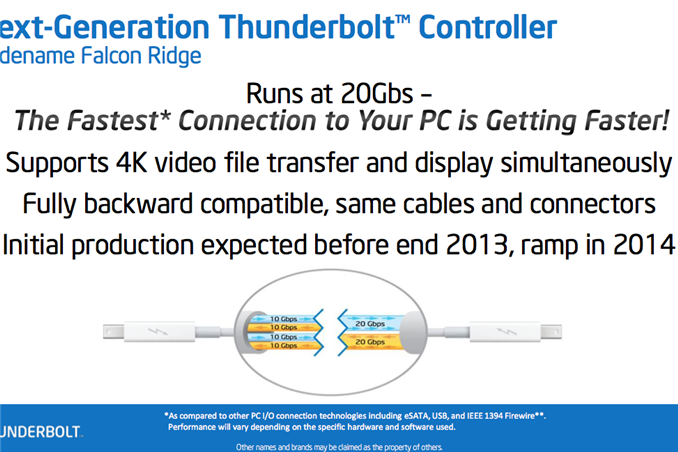Intel Confirms Falcon Ridge Production in 2013, Ramp in 2014
by Anand Lal Shimpi on April 9, 2013 1:51 PM EST- Posted in
- Storage
- CPUs
- Intel
- Thunderbolt

Yesterday Intel announced its updated Redwood Ridge Thunderbolt controllers (adding 4K/DP1.2 support, lower power operation and slightly lower BOM cost) as well as next year's Falcon Ridge family of Thunderbolt controllers. I assumed that Falcon Ridge would ship alongside Broadwell in late 2014 but I just got word that the new Thunderbolt controllers will begin production by the end of this year and ramp volume through 2014. I don't have more specific dates than that, but it's still good news.
All Intel is saying about Falcon Ridge is the spec includes a speed bump to 20Gbps per lane up from the current controllers with 10Gbps per lane. Intel's own presentation refers to a single channel/two lane Falcon Ridge controller, delivering no additional bandwidth above existing TB implementations (although there may be practical advantages since you can't easily aggregate all TB channels today). I would assume that we'd see even higher bandwidth implementations but Intel isn't talking about any of that today.










31 Comments
View All Comments
Hrel - Tuesday, April 9, 2013 - link
Until it comes standard on all motherboards and SOC's for all things, who cares?name99 - Tuesday, April 9, 2013 - link
Uhh, what?This is a blog devoted to telling us the FUTURE of tech. What do you expect?
Do you make the same comment when Anand discusses Haswell (which I can't buy yet) or 802.11ac (which has only just become buyable) or next generation LTE?
There are plenty of complaints you can make about TB, but yours has to be the most foolish.
SomeoneSimple - Tuesday, April 9, 2013 - link
In Hrel's defense, if anyone outside of fruity companies would actually make an effort supporting Thunderbolt by implementing this in both devices as well as peripherals, information about its successor would be a lot more exciting.repoman27 - Tuesday, April 9, 2013 - link
The same could be said about laptop displays with resolutions higher than 1366x768 that come calibrated from the factory.Hrel's comment isn't really defensible.
Tams80 - Sunday, April 14, 2013 - link
Thunderbolt is essentially the Apple implementation that Intel are now using to describe it as a whole. Light Peak is the name for the actual technology (though I guess at least in terms of publicity this has been dropped) and had other implementations, such as on the Sony Vaio Z 2011. It used a USB 3.0 port and another pin connector.If I recall correctly, Intel aren't exactly in favour of this, as Alexvrb pointed out, because they pretty much lost control of USB.
epobirs - Tuesday, April 16, 2013 - link
Intel never had control of USB. It didn't start at Intel and has always been a collaboration of multiple companies, although one of the five founding members (Compaq) acquired another of the founders (DEC). The USB TA has always had final say over any additions to the USB standard and controls the logo certification process. Intel wield a lot of power within the TA but they always wanted it to be independent for the purpose of encouraging wide adoption.Intel simply doesn't want multiple versions of the connectors creating confusion. Sony has done this before. I have an old VAIO laptop that has a four pin 1394 port and a 2 pin power port next to it. Using a cable that combines the two you can connect a standard six pin FireWire cable. It's a bit of a hack because Sony got impatient waiting for the FireWire connector spec to be finalized.
Compare the history of USB to FireWire and you'll see why one took off and the other remained a niche technology. It better served the purposes of the companies involved to not kept close control and try to monetize the technology itself rather than take the long view of benefiting from the overall improvement to their products.
Alexvrb - Tuesday, April 9, 2013 - link
Intel worked with Apple to make TB an Apple exclusive for a while. Between the exclusive head-start, their high-cost proprietary machines, and Apple's constant need to sell new devices with interfaces that won't work with older hardware, it's pretty obvious why Apple is such a strong Thunderbolt supporter.Not to mention that Intel was never interested in an actual standard that anyone can implement. They'd rather use their muscle to push TB on the world and sell TB controller chips, and prevent other parties from making compatible controllers.
inovice - Wednesday, April 10, 2013 - link
Actually the whole concept behind Intel`s Light Peak was to have one cable/connector to connect to multiple devices. I know someone who was working on Hybrid Silicon Laser technology and research (back in 2007). It was brought up by Steve Jobs himself, while having a chat with Intel folks. Apparently Steve complained about laptop ports (need USB, display, Ethernet etc..) and was seeking for alternatives. I think Apple was still working on MacBook Air prototype around that time (2006/2007). Apple had their hands on TB first before anyone because the idea to simplify laptop peripherals came from them. TB was developed and tested at Silicon Photonics (Google it). Light Peak would have seen the day without input from Apple. Just wanted to share:)ssj4Gogeta - Thursday, April 11, 2013 - link
AFAIK, Apple only designed the connector.russdarens - Monday, April 15, 2013 - link
"High cost proprietary machines"?Apple laptops dont cost any more than comparable HP or Dell business class laptops. And there is nothing proprietary about a Mac. It's Intel hardware. You can load it up with windows and it will run just fine as a windows computer.
You may as well be complaining about Subarus that have that dang 5 bolt lug pattern so they can't fit Honda wheels.